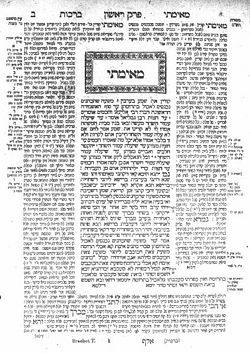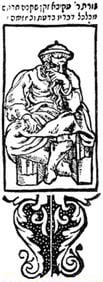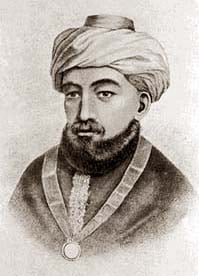Mishnah
 From Nwe
From Nwe 
The Mishnah (Hebrew: משנה, "repetition"), is the first written recording of the Oral Law of the Jewish people. Traditionally, it is thought to have been redacted (edited) around 200 C.E. by Rabbi Yehudah Ha-Nasi, also known as "Judah the Prince." It includes the often divergent religious opinions championed by the competing schools of the Pharisees and debated between 70-200 C.E. by the group of rabbinic sages known as the Tannaim. It is considered the first work of Rabbinic Judaism.
In the centuries after its initial redaction, commentaries on the Mishnah known as the Gemara (Aramaic: "Tradition") were compiled together with the Mishnah into the work known as the Talmud. The core of the Talmud is the Mishnah.
The Mishnah consists of six major orders (sedarim), each containing between seven and 12 tractates (masechtot), which are further divided into verses. The orders include:
- Zeraim ("Seeds"), dealing with agricultural laws and prayers
- Moed ("Festival"), pertaining to the laws of the Sabbath and the ritual celebrations
- Nashim ("Women"), concerning marriage and divorce
- Nezikin ("Damages"), dealing with civil and criminal law
- Kodashim ("Holy things"), regarding Temple rites and the dietary laws
- Tohorot ("Purities"), pertaining to the laws of purity, including the treatment of the dead, the priesthood, sexual purity, menstruation, etc.
Most modern editions of the Talmud are organized with each Mishnah section followed by its associated Gemara commentaries. A Mishnah section may only be a few lines or short paragraph, followed by much longer commentaries by various authorities of several pages.
Context
After the destruction of the Temple of Jerusalem in 70 C.E., rabbinical interpretations became increasingly important since the authority of the Temple priesthood diminished. The rabbinical leaders, comprised primarily of the movement known as the Pharisees, debated both major and minor points of contention within the Torah. However these had not been formally compiled. In the wake of the persecution and scattering of the Palestinian Jewish community following the Bar Kochba revolt of the mid-second century, there was real fear that the oral tradition might be lost to posterity. By 200 C.E., much of the Oral Law was edited together into the Mishnah.[1]
Over the next four centuries, this material underwent further analysis and debate—known as Gemara ("completion")—in the world's two major Jewish communities, in the former territory of Israel and in the Babylonian Empire. These debates eventually came to be edited together into compilations known as the Talmud: the Jerusalem Talmud for the compilation in Israel, and the Babylonian Talmud for the version undertaken in Babylon, which ultimately became the main center of Jewish learning. Additional commentaries, based on the writings of European Jewish sages, were added to the Talmud in the medieval period.
Attitude toward scripture
Rabbinical Judaism holds that written Torah exists in parallel with an oral tradition, and that both of these were given to Moses at Mount Sinai. The first, known as the "Written Law," is composed of the five "Books of Moses," namely Genesis through Deuteronomy.[2] The second law given to Moses also takes the form of the expositions of the Torah relayed by the scholars, prophets, and sages of each generation. This Oral Law is, in a certain sense, the more authoritative of the two, in that it is the basis for properly understanding the Written Law. Thus, Jewish law and custom—referred to as Halakhah—is based not only on a literal reading of the Torah, but on the combined oral and written traditions.
Interestingly, the Mishnah intentionally preserved contrasting, often diametrically opposed rabbinical opinions of various issues. For example:
- "One who recites Shema but doesn't make it audible to his ear has fulfilled his obligation.
-
- Rabbi Yosei says: Has not fulfilled his obligation."
- "One who recites but does not articulate each letter:
-
- Rabbi Yosei says: Has fulfilled his obligation.
-
Rabbi Yehuda says: Has not fulfilled his obligation."
- —Seder Zeraim, Tractate Berakhot, chapter 2.3
Thus, it takes the position that revealed truth can sometimes exist dialectically, and that members of the believing community can remain united despite opposing views of matters of both theology and practice. This attitude has enabled Judaism to avoid permanent schisms for the most part, in contrast to the Christian tendency to more easily condemn divergent theological views as heresy.
The Mishnah does not cite a written scriptural basis for its arguments and dicta. This is in contrast with the Midrashim (singular: midrash), commentaries in which the scriptural sources are specifically identified. These commentaries often predate the Mishnah.
Authorship and writing
The period of the Mishnah is commonly divided into five stages according to generations of the Tannaim—the sages of whose opinions the Mishnah is composed. There are approximately 120 known Tannaim. They lived in several areas of Judea, later known as Palestine.

The spiritual center of Judaism at that time was Jerusalem, but after the destruction of the city and the Temple in 70 C.E., Rabbi Yohanan ben Zakkai and his students founded a new religious center in Jammia (Yavne). It would be here that many of the debates described in the Mishna were recorded.
The generations of the Tannaim included:
- First Generation: Yohanan ben Zakkai's generation (c. 40 B.C.E.-80 C.E.).
- Second Generation: the time of the rabbis Gamliel II, Eliezer and Yehoshua—the teachers of Rabbi Akiva.
- Third Generation: The generation of Rabbi Akiva and his colleagues.
- Fourth Generation: The generation of Rabbi Meir, Rabbi Yehuda and their colleagues.
- Fifth Generation: Rabbi Judah Ha-Nasi's generation, during which most of the Mishnah was compiled.
- Sixth Generation: The interim generation between the Mishnah and the Talmud: rabbis Shimon ben Judah Ha-Nasi and Yehoshua ben Levi, etc.
Many of the Tannaim worked as laborers in addition to their duties as teachers and legislators. They were also leaders of the people, and negotiators with the Roman Empire.
Some Jews did not accept the written codification of the Oral Law, but insisted on the authority of the Written Law only. Known as Karaites, they comprised a significant portion of the world Jewish population around the tenth and eleventh centuries CE. Some communities of Karaites still exist, though they currently number in the thousands.
Additional commentaries
- The famous commentary of Rashi (1040-1105) does not focus on the Mishna per se, but covers nearly all of the Babylonian Talmud (a total of 30 tractates). It has been included in every version of the Talmud since its first printing in the fifteenth century.

- In 1168, the medieval sage Maimonides was the first known writer to author a comprehensive commentary on the Mishnah itself. Written in Arabic, it condenses the Talmudic debates and offers Maimonides' conclusion on a number of undecided issues. Of particular significance are the various introductory sections, as well as the general introduction to the work itself. These are widely quoted in other works on the Mishnah and the Oral law in general. Perhaps the most famous is his introduction to the tenth chapter of tractate Sanhedrin where he enumerates the 13 fundamental beliefs of Judaism. Maimonides' commentary came to be considered authoritative and was normally included in subsequent versions of the Talmud.
- Rabbi Samson of Sens (France) was, apart from Maimonides, one of the few rabbis of the early medieval era to compose a Mishnah commentary. It, too, is printed in many editions of the Mishnah.
- Rabbi Obadiah ben Abraham of Bertinoro (fifteenth century) wrote one of the most popular Mishnah commentaries. He drew on Maimonides' work but also offered material following the commentary of Rashi.
- After the Maharal of Prague had initiated organized Mishnah study, Yomtov Lipman Heller wrote a detailed analytical commentary called Tosafoth Yom Tov.
Other important Mishnah commentaries were written by Rabbi Solomon Luria, the Vilna Gaon, and Rabbi Akiva Eiger. A prominent commentary from the nineteenth is Tifereth Yisrael by Rabbi Yisrael Lipschutz. The commentary by Rabbi Pinhas Kehati, which is written in Modern Israeli Hebrew and based on classical and contemporary works, became popular in the late twentieth century. It was designed to make the Mishnah widely accessible to a wide spectrum of learners of all ages.
Study of the Mishnah
Oral traditions and pronunciation
The Mishnah was and still is traditionally studied through recitation (out loud). Although ancient Hebrew does not include vowels, many medieval manuscripts of the Mishnah are vowelized, and some of these notations indicate how the material is to be chanted. Jewish communities around the world preserved local melodies for chanting the Mishnah and distinctive ways of pronouncing its words. Most editions of the Mishnah today reflect standard Ashkenazic vowelization. However, scholars indicate that many editions also contain errors.
Two institutes at the Hebrew University in Jerusalem have collected major oral archives which hold (among other things) extensive recordings of Jews chanting the Mishnah using a variety of melodies and pronunciation. These institutes are the Jewish Oral Traditions Research Center and the National Voice Archives.
Critical views
Both the Mishnah and Talmud contain little intentional biographical information. A typical section simply indicates that one rabbi said such-and-such, while another said so-and-so. Yet, sketchy biographies of the Mishnaic sages can often be constructed with historical detail provided by Talmudic and Midrashic sources.
Many modern historical scholars have focused on the timing and the formation of the Mishnah. A vital question is whether it is comprised mainly of sources which date from Judah the Prince's lifetime, or whether considerable later material has been inserted. Furthermore, are the opinions of the rabbis preserved from before the time of Judah the Prince accurate? And what has been omitted or lost as a result of previously well-known acrimony between the schools of Hillel and Shammai? Are Mishnaic disputes distinguishable along theological or communal lines, and in what ways do different sections derive from different schools of thought within early Judaism? Can these early sources be identified?
In response to these questions, modern scholars disagree widely. While some students of the Mishnah take the text quite literally, critical scholarship of the subject can be divided into three basic approaches:
- Some scholars hold that there has been extensive editorial reshaping of the stories and statements within the Mishnah (and later, in the Talmud). Lacking outside corresponding texts, they hold that we cannot confirm the origin or date of most of the Mishnah's statements and laws. We can also say little for certain about their authorship. In this view, the questions above are impossible to answer. See, for example, the works of Louis Jacobs, Baruch M. Bokser, Shaye J.D. Cohen, and Steven D. Fraade.
- Other scholars hold that although the Mishnah and Talmud have been extensively shaped by later editorial redaction, it contains sources which we can identify and describe with some level of reliability. In this view, sources can be identified to some extent because each era of history and each distinct geographical region has its own unique feature, which one can trace and analyze. See, for example, the works of Goodblatt, Lee Levine, David C. Kraemer and Robert Goldenberg.
- Still other scholars hold that many or most of the statements and events described in the Mishnah and Talmud occurred more or less as described, and that they can be used as basically reliable sources of historical study. Such scholars attempt to tease out later editorial additions and skeptically view accounts of miracles, leaving behind what they believe is a reliable historical text. See, for example, the works of Saul Lieberman, David Weiss Halivni, Avraham Goldberg and Dov Zlotnick.
Notes
- ↑ It should be noted that the Hebrew Bible as such did not yet exist at this time. Many of its books, of course, were widely known and read, but they were not bound in a single text, nor had an authoritative list of scriptures yet emerged.
- ↑ When the books of "Prophets" (Judges, Samuel, and Kings) and the books known as the "Writings" (Psalms, Proverbs, Job, etc.) are added to the Torah, the complete volume is called the Tanakh, or Hebrew Bible. It is this collection of books that Christianity knows as the Old Testament.
References
ISBN links support NWE through referral fees
Translations
- Blackman, Philip. Mishnayoth. The Judaica Press, Ltd., 2000. ISBN 091081800X
- Danby, Herbert. The Mishna. New York: Oxford University Press, 1993. ISBN 978-0198154020
- Neusner, Jacob. The Mishnah: A New Translation. New Haven, CT: Yale University Press. Reprint edition, 1991. ISBN 978-0300050226
Historical study
- Carmy, Shalom. Modern Scholarship in the Study of Torah: Contributions and Limitations. Lanham, MD: Jason Aronson, Inc., 1996. ISBN 978-1568214504
- Goldenberg, Robert. The Sabbath-Law of Rabbi Meir. Scholars Press, 1978. ISBN 978-0891302490
- McGinley, John W. "The Written" as the Vocation of Conceiving Jewishly. iUniverse, Inc., 2006. ISBN 978-0595404889
- Shanks, Elizabeth. Transmitting Mishnah: The Shaping Influence of Oral Tradition. Cambridge: Cambridge University Press, 2006. ISBN 978-0521857505
- Zlotnick, Dov. The Iron Pillar: Mishnah. New York: Ktav Publishing House, 1989. ISBN 978-0881253320
Credits
New World Encyclopedia writers and editors rewrote and completed the Wikipedia article in accordance with New World Encyclopedia standards. This article abides by terms of the Creative Commons CC-by-sa 3.0 License (CC-by-sa), which may be used and disseminated with proper attribution. Credit is due under the terms of this license that can reference both the New World Encyclopedia contributors and the selfless volunteer contributors of the Wikimedia Foundation. To cite this article click here for a list of acceptable citing formats.The history of earlier contributions by wikipedians is accessible to researchers here:
- Mishnah history
The history of this article since it was imported to New World Encyclopedia:
- History of "Mishnah"
Note: Some restrictions may apply to use of individual images which are separately licensed.
↧ Download as ZWI file | Last modified: 02/03/2023 21:37:38 | 216 views
☰ Source: https://www.newworldencyclopedia.org/entry/Mishnah | License: CC BY-SA 3.0
 ZWI signed:
ZWI signed: KSF
KSF